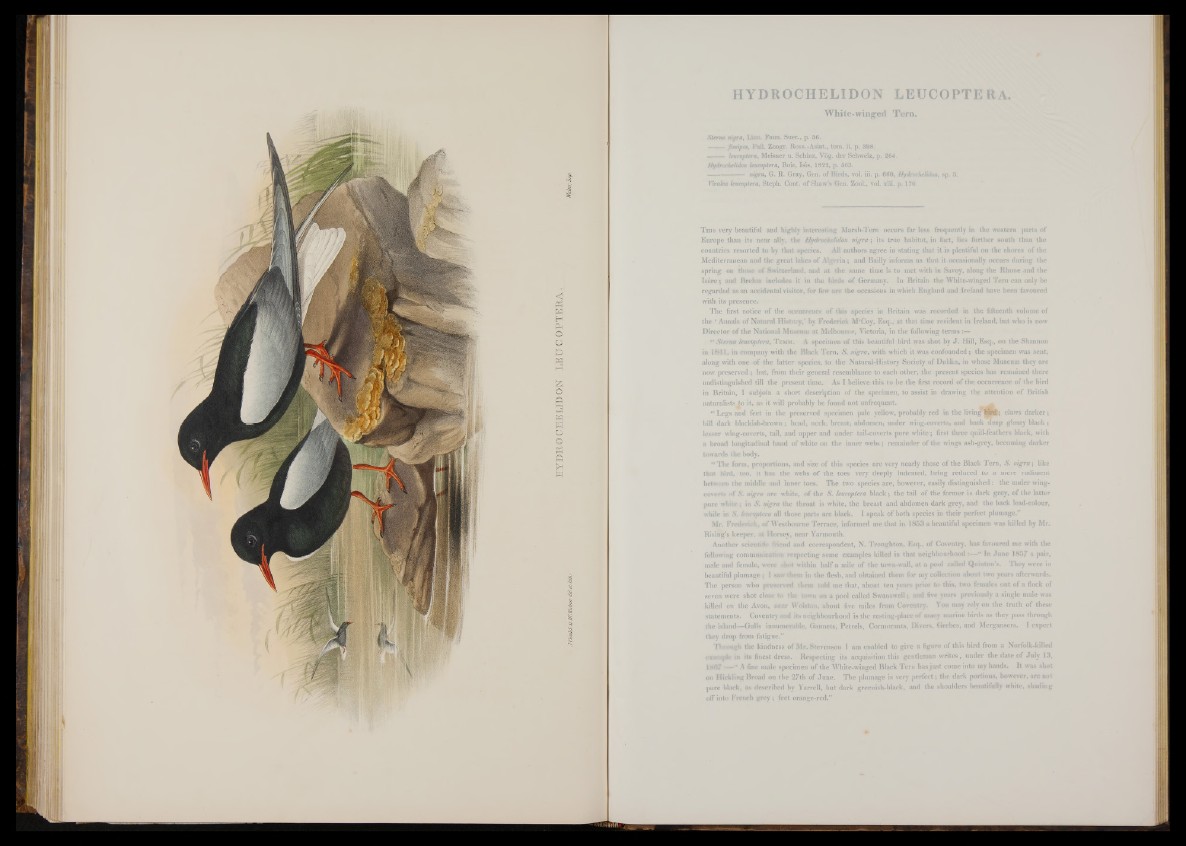
HYDB. O CHE LIB ON LEU COPT E EA .
White-winged Tern.
Sterna nigra, Linn. Faun. Suec., p. 56.
, . Mm... ßssipes, PalL Zoogr. Ross.-Asiat., tom. ii. p. 398.
leucoptera, Meisner u. Schinz, Vög. der Schweiz, p. 264.
Hydrochelidon leucoptera, Boie, Isis, 1822, p. 563.
----------------- nigra, G. R. Gray, Gen. of Birds, vol. iii. p. 660, Hydreehelidon, sp. 3.
Viralm leucoptera, Steph. Cont. of Shaw’s Gen. Zool., vol. xiii. p. 170.
This very beautiful and highly interesting Marsh-Tern occurs far less frequently in the western parts of
Europe than its near ally, the Hydrochelidon nigra ; its true habitat, in fact, lies further south than the
countries resorted to by that species. AH authors agree in stating that it is plentiful on the shores of the
Mediterranean and the great lakes o f Algeria ; and Bailly informs us that it occasionally occurs during the
spring on those of Switzerland, and at the same time is to met with in Savoy, along the Rhone and the
Isère ; and Brehm includes if in the birds of Germany. In Britain the White-winged Tern can only be
regarded as an accidental visitor, for few are the occasions in which England and Ireland have been favoured
with its presence.
The first notice o f the occurrence o f this species in Britain was recorded in the fifteenth volume of
the ‘ Annals o f Natural History,' by Frederick M‘Coy, Esq., at that time resident in Ireland, but who is now
Director of the National Museum at Melbourne, Victoria, in the following terms :—
“ Sterna leucoptera, T em m . A specimen o f this beautiful bird was shot by J. Hill, Esq., on the Shannon
in 1841, in company with the Black Tern, S . nigra, with which it was confounded; the specimen was sent,
along with one o f the latter species, to the Natural-History Society o f Dublin, in whose Museum they are
now preserved ; but, from their general resemblance to each other, the present species has remained there
undistinguished till the present time. As I believe this to be the first record o f the occurrence of the bird
in Britain, I subjoin a short description o f the specimen, to assist in drawing the attention o f British
naturalists Jo it, as it will probably be found not unfrequent.
“ Legs and feet in the preserved specimen pale yellow, probably red in the living bird ; claws darker ;
bill dark blackish-brown ; head, neck, breast, abdomen, under wing-coverts, and back deep glossy black ;
lesser wing-coverts, tail, and upper and under tail-coverts pure white ; first three quill-feathers black, with
a broad longitudinal band o f white on the inner webs ; remainder o f the wings ash-grey, becoming darker
towards the body.
“ The form, proportions, and size o f this species are very nearly those o f the Black Tern, S . nigra ; like
that bird, too, it has the webs o f the toes very deeply indented, being reduced to a mere rudiment
between the middle and inner toes. The two species are, nowever, easily distinguished : the under wing-
coverts of S . nigra are white, o f the S . leucoptera black ; the tail o f the former is dark grey, o f the latter
pure whit« ; in S. nigra the throat is white, the breast and abdomen dark grey, and the back lead-colour,
while in .V. leucoptera all those parts are black. I speak o f both species in their perfect plumage.”
Mr. Frederick, o f Westbourne Terrace, informed me that in 1853 a beautiful specimen was killed by Mr.
Rising’s keeper, at Horsey, near Yarmouth.
Another scientific friend and correspondent, N. Trougliton, Esq., o f Coventry, has favoured me with the
following communication respecting some examples killed in that neighbourhood :—“ In June 1857 a pair,
male and female, were shot within half a mile o f the town-wall, at a pool called Quinton’s. They were in
beautiful plumage ; I saw them in the flesh, and obtaiued them for my collection about two years afterwards.
The person who preserved diem told me that, about ten years prior to this, two females out of a flock of
seven were shot close to the town on a pool called Swanswell ; and five years previously a single male was
killed on the Avon, near Wolstou, about five miles from Coven try. You may rely on the truth o f these
statements. Coventry and its neighbourhood is the resting-place o f many marine birds as they pass through
the island—Gulls innumerable, Gannets, Petrels, Cormorants, Divers, Grebes, and Mergansers. I expect
they drop from fatigue.”
Through the kindness of Mr. Stevenson I am enabled to give a figure o f this bird from a Norfolk-killed
example in its finest dress. Respecting its acquisition this gentleman writes, under the date o f July 13,
1887 ■—“ A fine male specimen o f the White-winged Black Tern has just come into my hands. It was shot
on Hickling Broad on the 27th of June. The plumage is very perfect; the dark portions, however, are not
pure black, as described by Yarrell, but dark greenish-black, and the shoulders beautifully white, shading
off into French grey ; feet orange-red.”